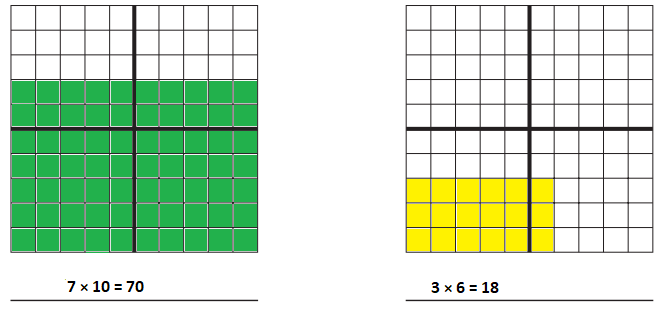Practicing the Bridges in Mathematics Grade 4 Home Connections Answer Key Unit 1 Module 2 will help students analyze their level of preparation.
Bridges in Mathematics Grade 4 Home Connections Answer Key Unit 1 Module 2
Bridges in Mathematics Grade 4 Home Connections Unit 1 Module 2 Session 2 Answer Key
Factors & Tea Lights
Question 1.
Imagine using 48 tiles to build each rectangle below. Write in the missing dimensions on the rectangle sketches.

Answer:
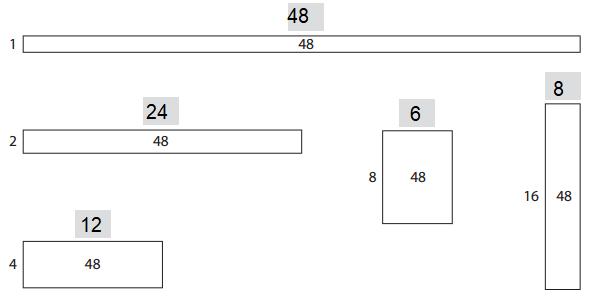
Question 2.
The fators of 48 are:
1 and ____ 2 and ____ 4 and ____ 8 and ____ 16 and ____
Answer:
The factors of 48 is
1 and 48, 2 and 24, 4 and 12, 8 and 6, 16 and 3.
Question 3.
a. Is 48 a prime number or a composite number?
Answer:
Given that the number is 48.
The number 48 is a composite number. Because 48 has more than 2 factors.
b. How do you know?
Answer:
A number which has more than two factors is called the composite numbers.
The number 48 has many functions.
Question 4.
Study your list of factors for 48. What patterns do you observe?
Answer:
If you double the one factor, you have the other to make factor pairs. The factors have one odd factor and one even factor or two even factors. you cannot have two odd factors and two even factor pairs.
Question 5.
Write the missing parts on this number line:

Answer:
The missing parts in the number line is
3 x 7 = 21
3 x 8 = 24
3 x 9 = 27
3 x 10 = 30
3 x 11 = 33
3 x 12 = 36.

Question 6.
Tea light candles are being packaged 6 to a box. Fill in the table:

For the problems below, use numbers, words, or labeled sketches to explain your answers.
Answer:
Given that,
Tea light candles are being packaged 6 to a box.
The number of boxes is 4.
The total number of candles is 6 x 4 = 24.
The number of boxes is 5.
The total number of candles is 6 x 5 = 30.
The number of boxes is 6.
The total number of candles is 6 x 6 = 36.
The number of boxes is 7.
The total number of candles is 6 x 7 = 42.
The number of boxes is 8.
The total number of candles is 6 x 8 = 48.
The number of boxes is 9.
The total number of candles is 6 x 9 = 54.
The number of boxes is 10.
The total number of candles is 6 x 10 = 60.

Question 7.
Jane has 7 tea light candles. Aisha has 5 times more candles than Jane. How many candles does Aisha have?
Answer:
Given that,
Jane has 7 tea light candles.
Aisha has 5 times more candles than Jane
The number of candles is 7 x 5 = 35.
Therefore the total number of candles does Aisha have is 35.
Question 8.
Theo has 50 tea light candles. Madeline has half as many candles as Theo. How many candles does Madeline have?
Answer:
Theo has 50 tea light candles.
Madeline has half as many candles as Theo.
The number of candles does Madeline have 50/ 2 = 25.
Therefore the number of candles are 25.
Bridges in Mathematics Grade 4 Home Connections Unit 1 Module 2 Session 4 Answer Key
Multiplication Fact Strategies
Doubles Plus One Set Facts
When one of the factors is 3, you can think about the Doubles fact, and then add one more set of the number being doubled. For example, 6 × 3 is 6 doubled (12) plus one more set of 6.
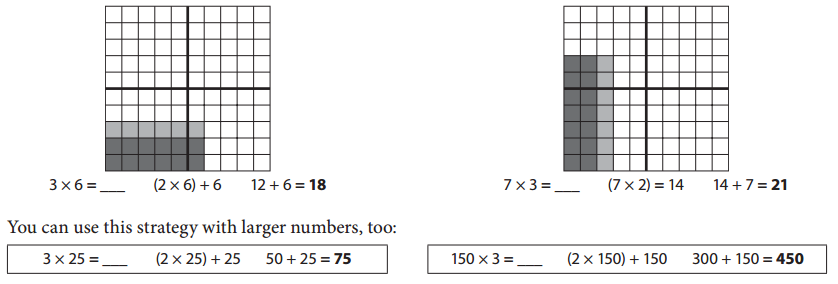
Question 1.
Shade in the areas and complete the equations.

Answer:
Given that,
3 x 5 it means shade the 3 rows and 5 columns.
3 x 8 it means shade 3 rows and 8 columns.
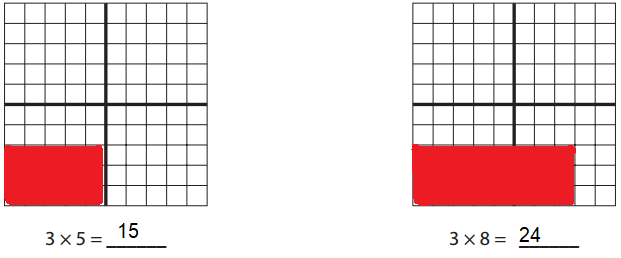
Question 2.
If you had 2 boxes of 8 crayons and your teacher gave you another box of 8 crayons, how many crayons would you have?
Answer:
Given that,
If you had 2 boxes of 8 crayons.
Your teacher gave you another box of 8 crayons.
The total number of boxes are 3.
The number of crayons are 3 x 8 = 24.
Question 3.
Cody bought 2 bags of 5 apples. He already had 1 bag of 5 apples at home. How many apples does Cody have in all?
Answer:
Given that,
Cody bought 2 bags of 5 apples.
He already had 1 bag of 5 apples at home.
The number of bags are 3.
The total number of apples are 3 x 5 = 15.
Therefore the number apples does Cody have in all is 15.
Question 4.
Write a story problem for a Doubles Plus One Set (×3) fact.
Answer:
Ravi has 4 apples. His friend Raju has double of Ravi’s apple. And the Sita has one set of 3 apples. Find the total number of apples.
Answer is Doubles = 4 + 4 = 8.
Doubles + one set(x3) = 8 + 4(3) = 8 + 12 = 20.
Tens Facts
Question 5.
Circle the groups of 10 in the arrays below, and solve the equations.
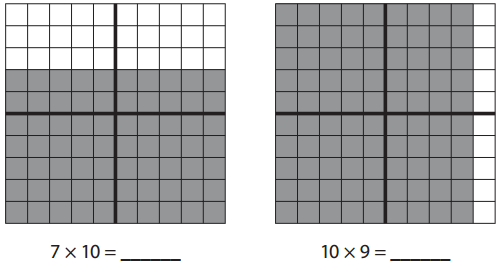
When you understand place value, multiplying larger numbers by 10 can be easy, too.
10 × 25 = 250 670 × 10 = 6700
Answer:
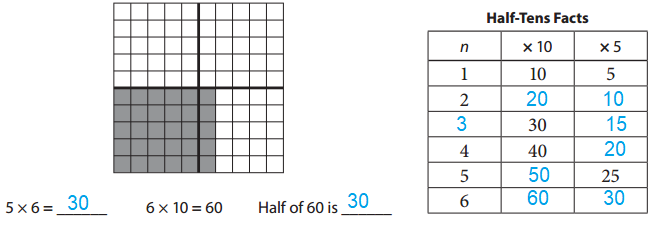
Half-Tens Facts
When one of the factors is 5, you can multiply the other factor by 10 and then divide the answer in half.
Question 6.
Fill in the blanks below.
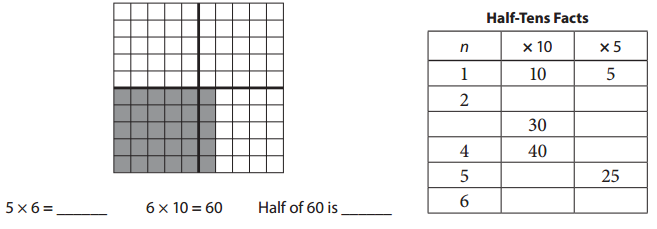
Answer:

Question 7.
Max had 6 dimes in his pocket. How much money did he have?
Answer:
10 dimes = 1 dollar.
6 dimes = 0.63 dollars.
0.63 dollars = Rs 51.35.
Therefore Max had Rs 51.35.
Question 8.
Jose had 7 nickels in his pocket. How much money did he have?
Answer:
1 nickels = 5 cents.
7 nickels = 5 x 7 = 35 cents.
35 cents = 0.231464 Rs.
Question 9.
If Suzie bought 9 baskets with 5 large peaches in each basket, how many peaches did she buy?
Answer:
Given that,
If Suzie bought 9 baskets with 5 large peaches in each basket.
The number of peaches that she buy is 9 x 5 = 45.
Therefore, Suzie buy 45 peaches.
Module 2 session 6
Multiplying by 8 & 9
Question 1.
Circle all the Double-Double-Doubles facts (×8) in blue. Then solve them and use a regular pencil to write each product.
Answer:

Question 2.
Circle all the Tens Minus One Set facts (×9) in red. Then solve them and use a regular pencil to write each product.

Answer:

Question 3.
a. Pick one fact from above and write it here: _________.
Answer:
b. Color in the array for that fact on the grid below.
Answer:
c. Label the array to show how you found the product, and use equations or words to explain your work.
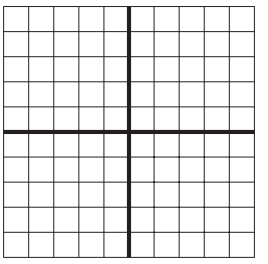
Answer:
Question 4.
Shade in and label the arrays of two more Double-Double-Double facts in the grids below. Write an equation for each fact.
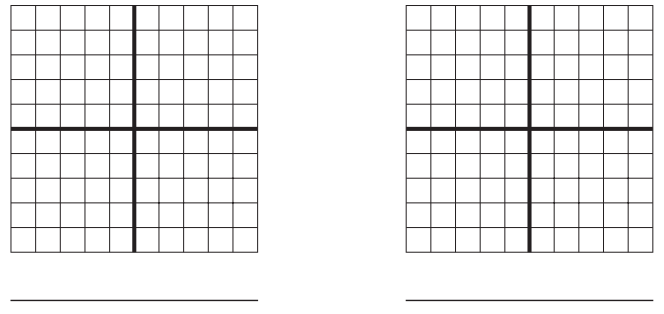
Answer:
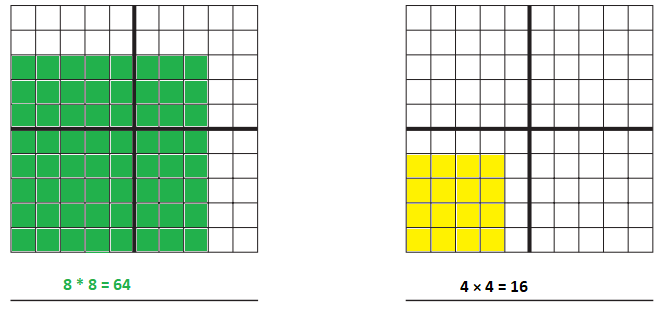
Question 5.
Shade in and label the arrays of two more Tens Minus One Set facts in the grids below. Write an equation for each fact.
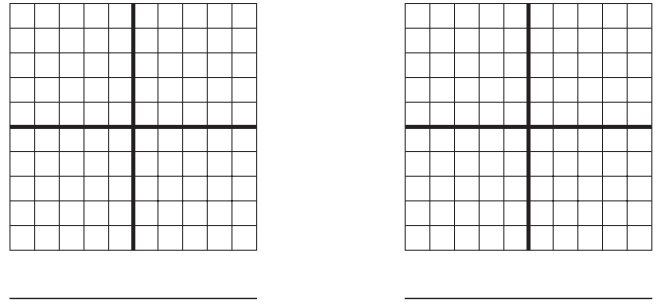
Answer:
